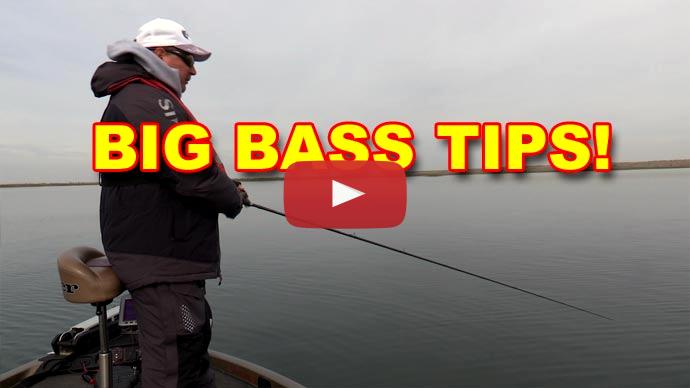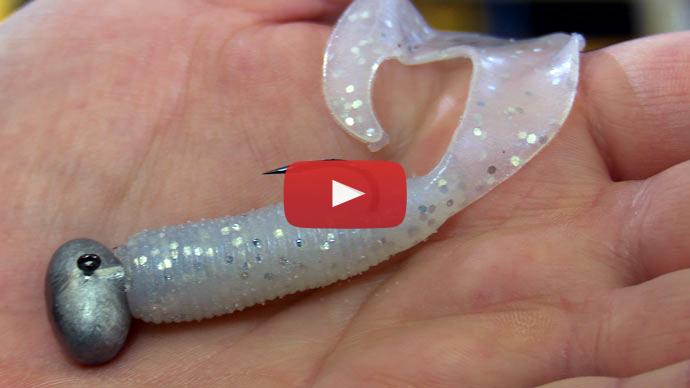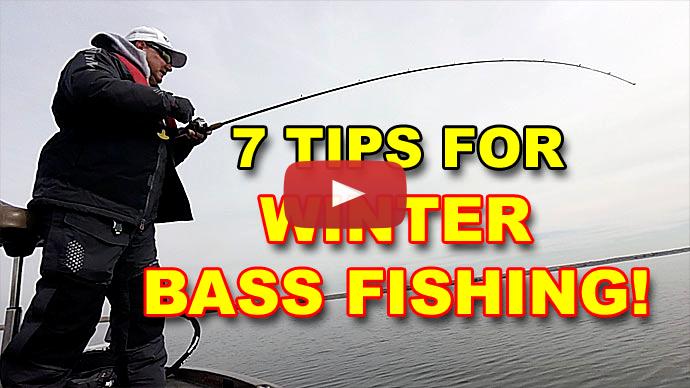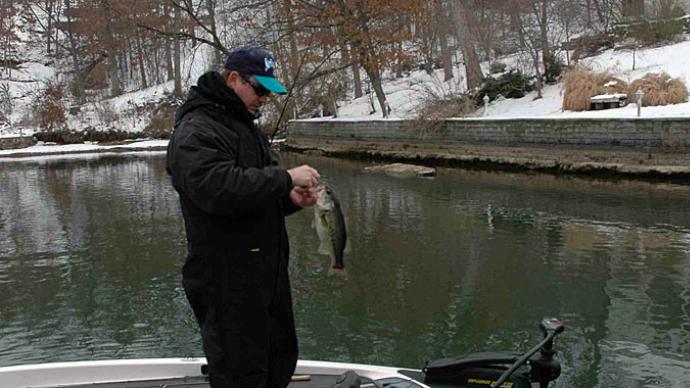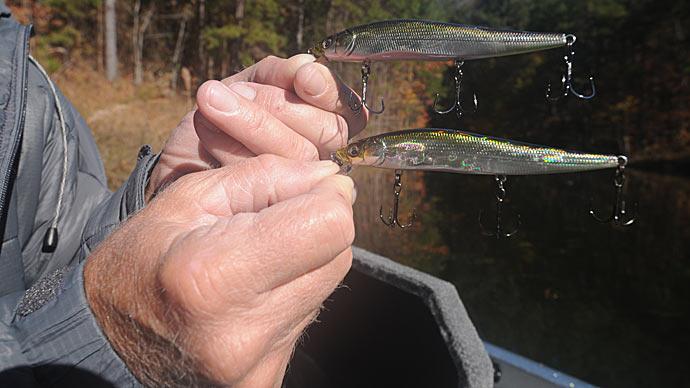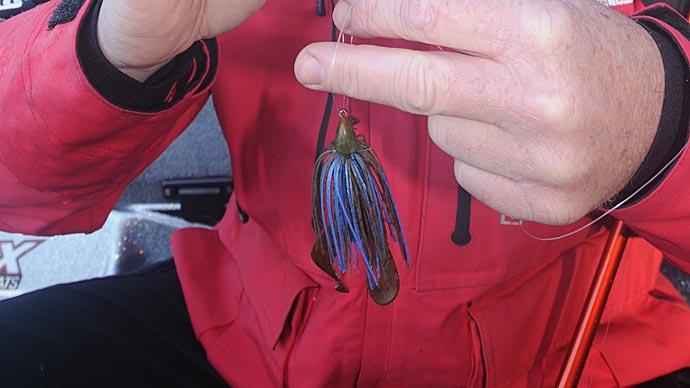Keri: Got one.
Glenn: There you go.
Keri: Hey, little guy. Little largemouth. Little guy had to eat it. Had to eat it. Had to eat it. Just had to have that split shot.
Glenn: Give it to me.
Keri: You're fattening up, little guy. There you go.
Glenn: Decent fish.
Keri: That's a pretty decent little guy.
Glenn: That'll work.
Hey, folks, Glenn May here with BassResource.com. And today I wanna talk about winter fishing. Winter can be tough sometimes. It's slow and the bites are few and far between. So it can be, you know, a challenge to keep your focus and really don't wanna stay out there sometimes. It can get boring. So, the challenge can be sometimes is what bait to use, even. What lure to use. And so what I want to do today is help you at least out in that area. I'm gonna go over my top five baits that I use throughout the wintertime and how I use them and where I use them. And hopefully, that will help you catch more fish this wintertime.
So let's get right into it, starting with the jig. I use two kinds of jigs during the wintertime. One is the rubber skirt jig and the other is the hair jig. So let's dive right into it. The rubber jig first.
There's two ways I fish that. One is the most common way that I fish it is I'll use that rubber jig in deeper structure. Because I'm in deeper structure, I'm using football head jig because there's not as much vegetation down there and also because there's more rocks than vegetation. I'm talking deeper than 15-feet. I use fluorocarbon line. And that's critical. I'm using fluorocarbon line in this instance because, number one, with those rocks down there, braid doesn't hold up to rocks as well as fluorocarbon.
And last thing you want to do is during the wintertime when you get bit, it's usually a good size fish and you don't wanna have a breakoff because you've been dragging your braid over rocks for the past couple of hours and you get the fish of a lifetime, that's just heartbreaking. So fluorocarbon for me and also in the wintertime lakes and rivers tend to be clearer and fluorocarbon isn't as visible as braid. And you're using real slow presentations so I just...you know, the bass have a lot of time to examine your presentation and what you're offering. So I wanna make sure that I put the odds in my favor.
So I'm using straight fluorocarbon and I'm dragging this jig deep over structure. I'm looking for long points, I like steep banks, any kind of humps that are down there, rock piles, as deep as 50-feet. Just look on the bottom with your depth finder and try to find any anomalies and fish that.
Alls I'm doing is I'm dragging it over this stuff. With a football head jig, as it drags on the bottom, it kind of wobbles back and forth. So it looks like a little crawdad moving along. Yes, crawdads are alive and well during the wintertime. They don't hibernate. They do move along. However, they don't move much. They are a lot more lethargic.
So with that in mind, I do two things. Number one, when I'm dragging it on the bottom, I'm not hopping and jerking it and causing all kinds of rod movement and all that stuff. I'm just letting it slowly move along the bottom, maybe letting the wind drift the boat along.
The other thing is I change my craw trailer. Whereas in the summertime I like to use a Rage Craw because it's got a lot of movement and action in it, I'll change that up. During the wintertime, I'm using like a Zoom Chunk or maybe a V&M Cherry Bug, something that doesn't have a whole lot of action to it, doesn't have a lot of movement. That perfectly resembles a crawdad during the wintertime.
The other way I'll fish a rubber jig is if I'm on a lake that has a winter drawdown more than 5-feet, what happens is these crawdads, they're up in the mud, they're up on the rocks, hanging out. When that water starts to drop, they gotta move deeper. So they come out and they're moving around and they're vulnerable. And the bass know this. And so they move up shallow to feed on them. So if that happens, then I fish the rubber jig just as I do during the spring or the summer. I flip and pitch and throw to every visible piece of cover I can find up to 15-feet deep. Docks, rocks, logs, you know, chunk rock, laydowns, anything I can find, find any kinda...there's remnant weeds that are green, any kind of weed edges along there, I'll fish that. That type of thing can be a real bonanza, especially if you had a little bit of a warming trend and the water's dropping. It can be a lot of fun. So don't miss out on that shallow water action should that occur.
Now the hair jig, I fish it two ways. One is exact same way the rubber jig, fishing it deep. I'm fishing a 1/4 ounce to 1/2 ounce hair jig, same with that rubber jig, fishing it deep, just crawling along the bottom. With a hair jig, I don't use any craw, any craw trailers. Maybe I might use a little mini trailer, maybe, but usually I don't. Just it's looking more like a sculpin, that's just...and sculpins don't come off the bottom, they just go along the bottom. So again, not hopping and dropping and doing all kinds of weird stuff, just dragging. Okay, it seems boring but it works.
The other way I fish a hair jig is you'll find that sometimes in the wintertime where schools of bait fish will ball up and they'll be situated a bit off the shore kind of suspending. When that happens, look in your depth finder, If it's a tight ball, that usually means there's bass around feeding on them. If it's a big loose ball then they're not worried, there's probably nothing feeding on them. So pass that one along. But if you find a tight ball, I take that hair jig and I drop it down right through that school of bait fish. Bass are usually on the bottom feeding on 'em and so I want that jig to punch through that school of bait fish to those bass below and it usually gets inhaled when it gets there. So that's a real cool way to fish a hair jig. It resembles a bait fish and the bass just can't stand it when you fish it that way. So jig, gotta fish it in the wintertime.
Okay, the next bait I want to talk about is the grub. Yeah, the simple grub. It's not used very much, you know, I don't know why. It's not as popular as it used to be, but I use them a lot. Three-inch grubs and 5-inch grubs is all I use, I put them on a football head jig, a 1/4 ounce football head jig, and I'm fishing it deeper than 15-feet deep, open hook. Because there's not a lot of weeds down there, there's not a lot to get snagged on, it's just basically rock and mud. So I'm using fluorocarbon line because fluorocarbon line holds up better against rock than braid and still has all that sensitivity. And I'm using a white grub. The reason I use a white grub is because when you're fishing that deep, I fish at sometimes up to 50-feet deep, there's not a lot of light penetration getting down there, so the colors really don't show up. So alls I'm really looking for is something for contrast against the bottom of a lake or river. So white, straight up white.
And I just drag it across any kinda structure I can find. Now that could rock piles, that could be humps, ridges, that could be long tapering points, I like steep banks, anything I can find, maybe some rocks down there. Sometimes there's debris. I've found some good spots where there's discarded 55-gallon drums down in 45-feet of water. They hold fish. So, you know, pay attention to your depth finder. Find anything down there that's different than the lake bottom and fish that, just drag it, let the wind slowly drift you over. You're not hopping and popping it and giving it all kinds of action. You just wanna drag it slowly, occasionally give it these long pauses. And that can be dynamite, especially in the coldest part of the winter, that seems to work best for me.
Another bait I like to use is the 4-inch plastic Finesse Worm. Specifically a hand-poured Finesse Worm. Now the reason I like hand-poured is because in the wintertime when the water temperature gets below 50 degrees, plastics tend to lose some of their flexibility. They're not as pliable so they don't have as much movement in 'em. A Finesse Worm, although it doesn't have a lot of appendages, it has a natural worm movement. The hand pours, they will stiffen up a little bit in that colder water, but because they're so flexible to begin with, they actually look really natural and normal in the colder temperature. So that's why I like hand pour. I usually use, like, I love the Don Iovino hand pours, there's several others on the West Coast that make hand pours. You can find them everywhere really.
The one exception would be for mass-produced would be the Roboworms. Those look and feel like hand pours and they work just as well in the wintertime. So if you can't find any actual hand pours or can't afford those, go with the Roboworms.
But what I'll do is I'll put those on a drop shot rig and on a split shot rig. I'll use the split shot rig to find fish and I'm fishing deeper than 15-feet, sometimes as deep as 50, and I'm looking for structure. Anything that's different from the bottom contour. So humps, ridges, ledges, rock piles, those kinda things. I like steeper points, steep banks. Those types of things is what I'm looking for. And I just drag that split shot over the top of that cover or that structure, I mean. And sometimes I just let the wind just kinda drift the boat along and I'll pause it. I'll make long pauses in between such as 4 seconds, up to a 30-second long pause. And when I do move it I'm lifting it and hopping it off the bottom, or twitching it, or shaking it, or giving it any of that extra action, just slow and steady drag on the bottom.
Once I do get bit, then I'll switch over to a drop shot and I'll pinpoint that specific area where they bit. So, for example, it was a rock pile or it was on a point. I'll work it thoroughly with that drop shot, vertically jigging it. The difference is in the summertime I may use an 18-inch leader, maybe longer than that, but in the wintertime, I'm using an 8 to 10-inch leader. Because these fish are right on the bottom I wanna get this right to them. And I'll just let it hang out. You know, just maybe move that rod tip just slightly, just subtle movements, if that... But just let it sit in place and maybe let the wind kinda drift the boat a little bit. But slowly work it slowly. This is why I use the split shot first to find the fish. Once you get bit, typically in the wintertime the fish are congregated. They kind of school up. So if you catch a fish in an area, there's generally more in that area. This is why I go back to the drop shot to work that area more thoroughly to pick off as many fish as I can. So a 4-inch Finesse Worm, that is key to this presentation.
The next lure I like to use during the wintertime is the blade bait. This is a bait that's proven over decades. It works great during the wintertime. It's very simple to use, what makes it so productive is it's a small bite-size meal, basically, and it has a tight vibration, which is key during the wintertime. The tighter the vibration, the better. It's also a heavy piece of metal that just casts like a bullet. It doesn't have a lot of wind resistance, so it's very easy to cast, which is what you need for the presentation. What I do is I throw it out across deep points, I'm fishing at deeper than 15-feet deep, sometimes up to 40-50-feet deep. Cast it out over these humps, ridges, rock piles, creek ledges, any kind of difference in the bottom contour is what I'm looking for, something different.
Cast it way out, let it get down near the bottom, almost on the bottom, and here I just slowly crank it just nice and slow. I wanna maintain bottom contact but I don't want it to be bouncing along the bottom. I wanna keep it off the bottom but every once in a while I hit the bottom so I know it's down there. And just slowly crank it back. Sometimes I give it a little pop and let it flutter back down and hit the bottom and then pick up, reel it again just to make sure contact with it. And that little pop and that flutter sometimes is what you need. Sometimes that yo-yo action. Just bring it up and then let it drop down, hit the bottom. Pop it back up slowly and let it drop right back down. That falling action, sometimes you'll get bites that way. But usually, just a straight, steady, slow retrieve over this bottom structure is all you need for wintertime fishing.
All right, so the next bait that I wanna talk about is the suspending jerkbait. I like fishing a suspending jerkbait because it resembles a dying or, you know, a bait fish that's struggling to stay alive, struggling to stay upright, which is an easy meal for bass. So I fish these on fluorocarbon line because the water's really clear and it's a slow presentation so the bass have a lot of time to examine your lure, and I don't want that lure to look unnatural to them. So fluorocarbon is what I use. I get a suspending jerkbait that dives to at least 10 feet, if not deeper. And I wanna fish these over weed beds, specifically if I can find deep weed edges, if I can find points, maybe at the top of a hump or a ridge, steep banks, that type of thing.
The best time to fish this is when the water temperature's taken a plunge, you've had a cold snap. And maybe now there's a high-pressure system sitting overhead. That's usually when the bass kinda pull off and they suspend a little bit and that's the perfect time to get them with the suspending jerkbait.
Cast it out there, wind it down quick, get it down to the depth that they're at and then let it hang out. Just let it sit. And this is the key to fishing a suspending jerkbait, is how long you wait until you twitch it again. Wait at least 3 to 4 seconds, sometimes up to 30 seconds, and I've been known to wait up to a minute. And when you twitch it, that's what you do, it's a slight twitch. You're just resembling this bait fish that's struggling to remain upright, struggling to remain alive. So you're not popping it, no hard snaps this time like you would do during the summertime. It's a twitch. And then you park it again.
And the cadence, the duration between twitches, that's what you need to experiment with. That is key to catching those fish. So once you do get a bite, remember how far apart that was before your last twitch and try to mimic that, you'll start catching more and more fish.
You could try once in a while a hard snap. Sometimes that gets their attention. Occasionally you can get a bite out of that. But as a general rule, slight twitches, long pauses, that's how you fish it during the wintertime.
All right, so that's my top five baits that I use during the wintertime. I hope that helps. For more tips and tricks like this, visit BassResource.com.

